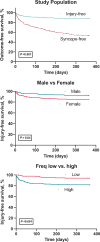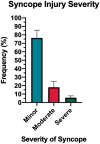Frequency of injuries associated with syncope in the prevention of syncope trials
- PMID: 32954415
- PMCID: PMC7758472
- DOI: 10.1093/europace/euaa246
Frequency of injuries associated with syncope in the prevention of syncope trials
Abstract
Aims: Syncope can lead to injuries. We determined the frequency, severity, and predictors of injuries due to syncope in cohorts of syncope patients.
Methods and results: Participants were enrolled in the POST2 (fludrocortisone) and POST4 (midodrine) vasovagal syncope (VVS) randomized trials, and POST3 enrolled patients with bifascicular block and syncope. Injury was defined as minor (bruising, abrasions), moderate (lacerations), and severe (fractures, burns, joint pain), and recorded up to 1 year after enrolment. A total of 459 patients (median 39 years) were analysed. There were 710 faints occurred in 186 patients during a 1-year follow-up. Fully 56/186 (30%) of patients were injured with syncope (12% of overall group). There were 102 injuries associated with the 710 faints (14%), of which 19% were moderate or severe injuries. Neither patient age, sex, nor the presence of prodromal symptoms associated with injury-free survival. Patients with bifascicular block were more prone to injury (relative risk 1.98, P = 0.018). Patients with ≥4 faints in the prior year had more injuries than those with fewer faints (relative risk 2.97, P < 0.0001), but this was due to more frequent syncope, and not more injuries per faint. In VVS patients, pharmacological therapy significantly reduced the likelihood of an injury due to a syncopal spell (relative risk 0.64, P = 0.015). Injury severity did not associate with age, sex, or prior-year syncope frequency.
Conclusion: Injuries are frequent in syncope patients, but only 4% of injuries were severe. None of age, sex, and prodromal symptoms associate with injury.
Keywords: Clinical trial; Injury; Injury severity; Syncope; Vasovagal.
Published on behalf of the European Society of Cardiology. All rights reserved. © The Author(s) 2020. For permissions, please email: journals.permissions@oup.com.
Figures


References
-
- Shen W-K, Sheldon RS, Benditt DG, Cohen MI, Forman DE, Goldberger ZD. et al. 2017 ACC/AHA/HRS Guideline for the evaluation and management of patients with syncope. J Am Coll Cardiol 2017;70:e39–110. - PubMed
-
- Ruwald MH, Hansen ML, Lamberts M, Hansen CM, Numé AK, Vinther M. et al. Comparison of incidence, predictors, and the impact of co-morbidity and polypharmacy on the risk of recurrent syncope in patients <85 versus ≥85 years of age. Am J Cardiol 2013;112:1610–5. - PubMed
-
- Barón-Esquivias G, Gómez S, Aguilera A, Campos A, Romero N, Cayuela A. et al. Short-term evolution of vasovagal syncope: influence on the quality of life. Int J Cardiol 2005;102:315–9. - PubMed
-
- Blanc J-J, L’Her C, Touiza A, Garo B, L’Her E, Mansourati J.. Prospective evaluation and outcome of patients admitted for syncope over a 1 year period. Eur Heart J 2002;23:815–20. - PubMed
Publication types
MeSH terms
LinkOut - more resources
Full Text Sources

